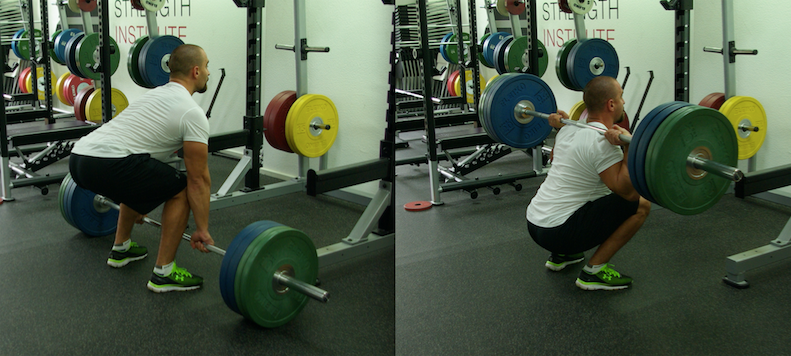I hear and read the statement that squats and deadlifts are the same thing from time to time. She is nonsense. Still, this claim comes up every now and then. It is even uttered by supposed experts.
In 2007 I got my trainer B license in Germany. One of the places I lost faith in the value of the B license was after the trainer claimed deadlifts weren't necessary since the squat was the same exercise. At that time, my level of knowledge was still relatively low. However, my practical experience from my own training already told me back then that this assertion is not correct.
Anyone who has ever performed the two exercises with optimal technique knows the difference.
Deadlifts and squats are both important compound movements that recruit a lot of muscle and have a great training effect on the whole body. Nevertheless, the differences between the two exercises are large.
And there are many differences. There are three important ones.
1. Knee and hip angle
There are big differences here (see picture). The mechanical efficiency and shorter range of motion in the major joints allows heavier weights to be used in the deadlift. The proportional distribution of hip and knee extensor muscles is different. The knee joint is fully flexed in the squat and must be extended a significantly longer distance than in the deadlift. The squat is primarily a full-range knee extension exercise with a large proportion of hip extension, while the deadlift is primarily a hip extension exercise with a proportion of knee extension past 90 degrees at the knee joint.
The synchronization of the movement sequence is also different. When deadlifting, a parallel displacement of the knee and hip joints takes place at the same time. In the squat, the knee joint is first actively bent/stretched in the starting position before the hip flexion/extension begins.
2. Fascial Tension vs. Inertia
The difference here is starting at the top of the squat vs. starting at the bottom of the deadlift. When deadlifting, the inertia of a "dead" weight must be overcome in the starting position, in which the weight is on the floor. Hence the English name "Deadlift". With no weight on the body, there is minimal fascial tension, resulting in greater central nervous system (CNS) overload during the deadlift. Accordingly, this exercise can be trained with the lowest possible frequency. If someone is strong at deadlifting, most of the time they can only do heavy deadlifts every 2 weeks to make progress.
When doing the squat, the starting position is with the weight on your shoulders in the standing position. Due to the resulting fascial tension during the eccentric phase of movement, energy is stored and released again. Therefore, there is less stress on the CNS. Accordingly, the highest training frequency with simultaneous progress is possible with the squat. The results produced by the trainees during the YPSI squat vacation confirm this impressively.
3. Mobility and muscular balance
In order to be able to move heavy weights with correct technique when squatting, the front chain and the back chain must be developed in balance with one another. The muscles for both knee and hip extension must be fully developed. In addition, a high degree of mobility is necessary for a strong squat, since the knee joint is completely bent and the hip joint is strongly bent.
Low mobility is necessary when deadlifting. The posterior chain is primarily used to stretch the hips. The front chain can be very weak. As you improve your squat performance, your deadlift performance will improve as well. Vice versa this is not the case.
Conclusion: Both exercises are important. The squat especially for beginners. Advanced deadlifts. The two exercises are not identical, there are many big differences - you got to know three important ones above.
If you want to improve your squat technique and performance in the shortest possible time and run home after 10 squat workouts in a day like John Wayne, sign up for the YPSI Squat Day ...
In order to learn or optimize the technique for deadlifts and squats as well as for the basic exercises bench press and pull-ups and to use them during 3 workouts, register for the seminar "Learning basic exercises in the YPSI" :
Image: YPSI trainer Goran Sirovina in the starting position of the deadlift and the bottom position of the squat. As you can clearly see, these are two different exercises.

